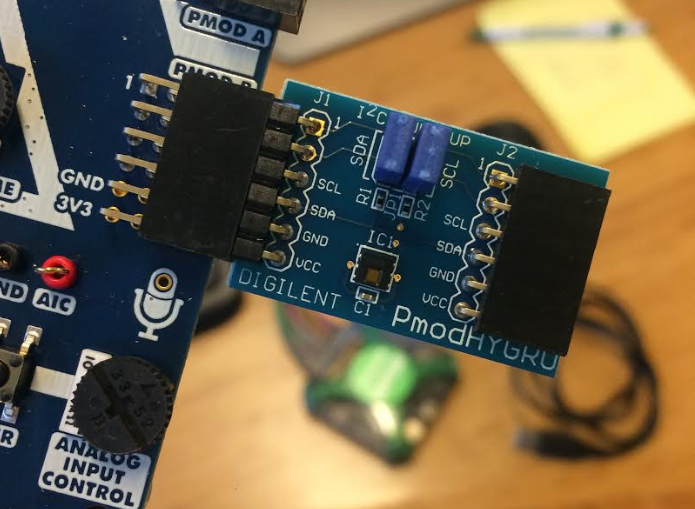 Announcing the addition of the Pmod HYGRO to the Pmod sensor family!
Announcing the addition of the Pmod HYGRO to the Pmod sensor family!
The Pmod HYGRO is a low power, 14-bit relative humidity sensor, also known as a HYGROmeter, with integrated temperature sensor. The module produces direct measurements of relative humidity (RH) as well as independent ambient temperature measurements, all over a simple I²C interface. Featuring the TI HDC1080, the Pmod HYGRO achieves an accuracy of ±2% for RH and ±0.2 °C for temperature, which is one of the more accurate sensors we found. Not to mention it includes an internal heater (resistive heating element) that serves to test the sensor as well as drive off moisture, helping to reduce any accumulated offset over time. Very useful!

How does it work?
To understand how the Pmod HYGRO works, you need to understand what relative humidity is. Very simply, it’s the amount moisture in the air (actual vapor density) expressed as a percentage of the amount of moisture the air can hold (saturation vapor density). The equation looks like this:

Because the saturation vapor density relies on temperature and pressure, this can be a very complicated thing to measure. Luckily, some modern sensors, like capacitive humidity sensors, can measure relative humidity directly. This is the case with the Pmod HYGRO. The above equation then becomes little more than a quick and easy register read:
![]()
Simple as that. Similarly, temperature readings can be converted to degrees Celsius by using the equation
![]()
To find out more about the details of acquiring data from the Pmod HYGRO, see the “Quick data acquisition” section of our reference manual.
Applications
A common application of a combined humidity and temperature sensor is in controlling HVAC (heating, ventilation and cooling) systems. Normally, we think of this as a system in which the sensors send the measurement data to a microcontroller that then adjusts the heating/cooling system to maintain a customer defined temperature. But did you know that low humidity can compromise your immune system and affect your sleep? Use the Pmod HYGRO to create a smart home hack and program your humidifier to maintain an RH of 50% during these dry winter months. It’s for your health! Other possible applications include greenhouse/indoor garden control, smart thermostats, handheld meters and DIY weather prediction.
Whatever your application of choice, it’s good to note that in order to keep measurements accurate and avoid any self heating of the HDC1080, it is recommended to use a maximum sample rate of 1 sps. This is plenty sufficient for in home systems. Combine that with the very low power of the TI HDC1080, and the Pmod HYGRO is an ideal choice for battery operated, home systems where relative humidity and ambient temperature data is required.
Getting started with the Pmod HYGRO
If you are an MCU user, we’ve written some libraries and example code to get you started monitoring your environment quickly with simple functions such as myHYGRO.getTemperature and myHYGRO.getHumidity. The example code was written in the Arduino IDE and should work smoothly with the chipKIT core. For download instructions, see our page on how to get started with the chipKIT core.
If using the Pmod HYGRO with a Digilent FPGA board, see our wiki page titled Using Pmod IPs for instructions on how to use our Pmod HYGRO IP core with MicroBlaze designs.
Questions or comments? Use the comment section below or visit the Digilent Forum!

